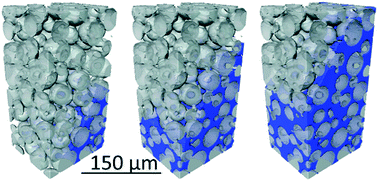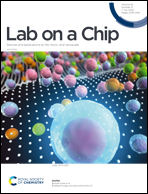4D synchrotron microtomography and pore-network modelling for direct in situ capillary flow visualization in 3D printed microfluidic channels†
Abstract
Powder-based 3D printing was employed to produce porous, capillarity-based devices suitable for passive microfluidics. Capillary imbibition in such devices was visualized in situ through dynamic synchrotron X-ray microtomography performed at the European Synchrotron Radiation Facility (ESRF) with sub-second time resolution. The obtained reconstructed images were segmented to observe imbibition dynamics, as well as to compute the system effective contact angle and to generate a pore-network to model capillary imbibition. A contact angle gradient was observed resulting in a preferential wicking direction, with the central portion of the microfluidic channel filling faster than the edge areas. The contact angle analysis and the pore-network model results suggest that this is due to spatial variations in the material surface properties arising from both the 3D printing and the subsequent drying processes.



 Please wait while we load your content...
Please wait while we load your content...